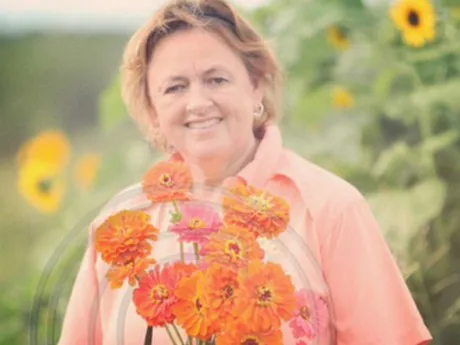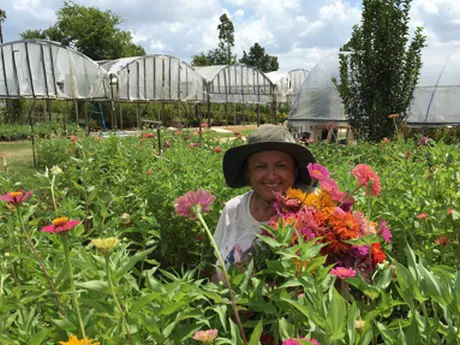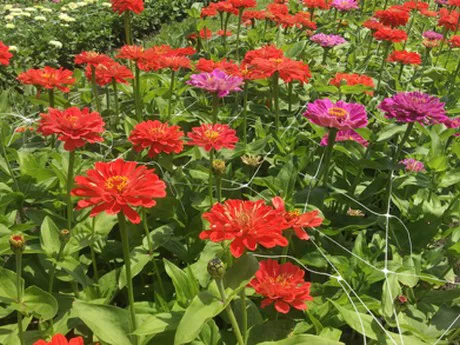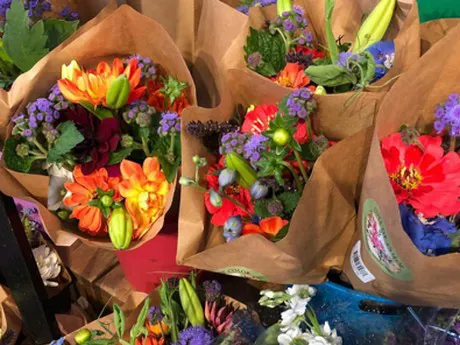With her roots deep in the soil of Texas, it was perhaps inevitable that Rita Anders would end up a farmer.
After all, she grew up on a dairy farm in Weimar, Texas, where her grandfather started farming in 1937. Her family also grew peaches and pecans.
 All photos courtesy of Cuts of Color.
All photos courtesy of Cuts of Color.
What wasn’t so inevitable was that she would become a flower grower, a wedding flower designer and an advocate for locally grown produce. All that came from within her. The result is Cuts of Color, a thriving Certified American Grown flower farm 90 miles west of Houston that produces a wide range of flowers that are harvested year-round.
Anders took an indirect route to get where she is now. Out of high school, she went to work at a building supply store. It wasn’t what she wanted to do, but she learned an important lesson – she didn’t like working for someone else.
“There were all these stupid rules and I just knew I liked working for myself,” she said.
Her grandfather had started growing greenhouse tomatoes and he offered Anders the chance to take over the operation after he retired.
“He had one 4,800 square-foot greenhouse,” she said. “I said, ‘OK, what do I do the other four days of the week?’”
What she did was steadily expand the operation.
“I rented four more greenhouses, and while I rented those, I started building four more of my own. On some land we bought, we added six more. We did that for 26 years. We grew greenhouse tomatoes for the Houston market and we sold everything we had.”

It was not until the early 2000s that flowers were even in the picture. But a convergence of events brought Anders’ latent affinity for flowers to the forefront – she was weary of growing tomatoes and a spike in butane prices made her greenhouse operation far less profitable. On top of that, her children were leaving the nest.
“I got burned out on it after 26 years,” she said. “I was done with it. All my kids went off to school and college and I was like ‘I don’t want to do this anymore. I want to do something different.’ I always loved flowers, so I started mixing in my flowers with the vegetables. And then I went completely into flowers in ’04.”
It was the rise in butane prices that gave her the big push to trade tomatoes for flowers.
“I just didn’t want to be working for the butane company, so I decided I would just keep going and use these greenhouses we have for flowers,” she said. “With flowers, we just open everything up, and when winter comes we just close it up. It uses nowhere near the amount of gas or electricity. We just said we’ll use the greenhouses till they fall down, but one did fall down and we put two up in its place.”
But it was not an easy road. With children in college, she took on a full-time job in addition to her farming operation. And she had to teach herself about growing flowers.
“We don’t grow tomatoes here in the summer because it’s too hot,” she said. “So, every summer for two or three years I’d read everything there was about flowers. I just decided to read up on flowers and see what I could do with it. And then I joined the Association of Specialty Cut Flower Growers. I learned so much from them about what to grow, when to grow it. I just learned from people. That’s how I did it.
“I took my chances. I made plenty of mistakes, don’t get me wrong.”
But Anders minimized the cost of those mistakes early on.

“I started with zinnias and sunflowers and celosia,” she said. “It was all seed crops. I did everything on my own. I didn’t order bulbs or plugs or anything. And that was the best thing because I made my mistakes on seed instead of planting a whole bunch of bulbs. That costs a lot of money.”
She first started selling her flowers in some of the same stores where she sold her tomatoes. She then branched out to a farmers market in Houston.
The first time, she “took 30 $10 bouquets to the market and we sold out in no time. I thought, ‘Oh, this is nice.’”
She also sold to florists and made deliveries. After customers suggested she start providing flowers for weddings, she taught herself how to do it. She read, watched YouTube videos and got some tips from one of her florist customers. She also drew on some long-ago lessons.
“My grandma used to make fake flowers,” she said. “She’d take wood fiber and make flowers for a whole wedding. She did tons of weddings like that. So, I guess I inherited some of that. With arranging things, some people have it and some people don’t.”
The wedding flower business eventually grew to the point where she had to start turning away customers.

In 2012, she landed a contract to supply flowers to Central Market in Houston, a place she describes as “a Whole Foods but on steroids.” That has proved to be a good fit – the market likes her locally grown blooms and eco-friendly approach, and she likes the steady business. She delivers flowers there twice a week and the store now accounts for about two-thirds of her business.
“We produce a lot and they buy everything,” she said. “They support me wholeheartedly.”
In addition, she offers farm tours and design workshops. She also sells directly from the farm. Cut of Color’s Facebook page regularly offers $10 bouquets for pickup at the farm.
With her kids grown and her husband retired, she can see the next phase of her life on the horizon. What that holds, however, isn’t clear. Perhaps a family member will eventually take it over.
“I could go to more stores and get bigger but I don’t want to,” she said. “My husband is 65 and he’s retired. I’m 60, and I’m not at the point where I want to go bigger. I’m happy with what I have.”
For more information: AmericanGrownFlowers.org
AmericanGrownFlowers.org
916.441.1701
info@americangrownflowers.org
www.americangrownflowers.org
